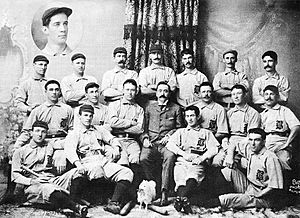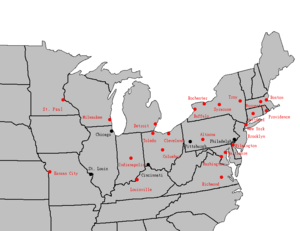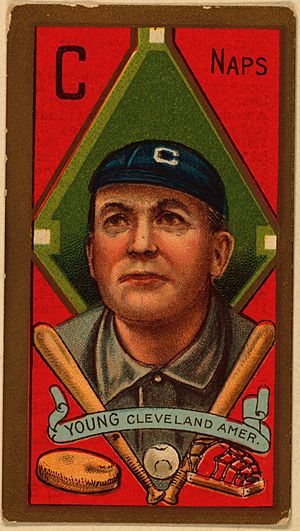History of baseball in the United States facts for kids
The history of baseball in the United States goes back to the 1800s. Back then, people played a game similar to baseball with their own simple rules and homemade gear. The game became very popular, leading to the creation of semi-professional baseball clubs in the 1860s.
Contents
Early Days of Baseball
The first time baseball was mentioned in the United States was in 1791. A law in Pittsfield, Massachusetts, said people couldn't play the game within 80 meters (80 yd) of the town meeting house.
In 1903, a British sports writer named Henry Chadwick thought baseball came from a British game called rounders. He had played rounders as a boy in England. But baseball executive Albert Spalding disagreed. Spalding believed baseball was an American sport that started in America. To settle the argument, they asked Abraham G. Mills to lead a group to find the truth. After three years, this group said that Abner Doubleday had invented baseball.
However, in 2004, a baseball historian named John Thorn found the 1791 Pittsfield law. This showed that baseball was played 48 years before Abner Doubleday supposedly invented it in 1839 in Cooperstown, New York. Cooperstown is now home to the National Baseball Hall of Fame and Museum. The Hall of Fame recognized the Pittsfield law as the first known mention of the game. Another early report says that "base ball" was played regularly on Saturdays in 1823, just outside New York City.
How Baseball Grew
Before the American Civil War, baseball was just one of many popular games, competing with cricket and other local versions of baseball.
In the 1860s, helped by the Civil War, "New York" style baseball became a national game. The first group to govern the sport was the National Association of Base Ball Players. By 1867, it had grown to over 400 teams, including some from far away places like San Francisco and Louisiana. One of these teams, the Chicago White Stockings, won the championship in 1870. This team is now known as the Chicago Cubs, and it's the oldest team in American organized sports. Because baseball grew so much, local and state groups started to play a bigger role in managing the game.
Baseball Becomes Professional
The Cincinnati Red Stockings were the first team to openly say they were professional. They were very good at finding and signing the best players. Twelve teams, including most of the strongest ones from the National Association of Base Ball Players, decided to become professional for the 1869 season.
Rise of the Major Leagues
In 1870, professional and amateur players separated. The National Association of Base Ball Players split into two groups. The National Association of Professional Baseball Players played from 1871 to 1875. Some people consider this to be the first major league. The amateur group disappeared after only a few years.
The early years of the National League were tough. There were threats from other leagues and players were unhappy about the "reserve clause." This rule limited how players could move between teams. New leagues often formed and then quickly disappeared. For several years, the champions of the National League and the American Association played against each other in a championship series. This was the first attempt at a World Series.
The Western League started playing in April 1894 with teams in cities like Detroit, Grand Rapids, and Sioux City. Before the 1900 season, the league changed its name to the American League. It also moved some teams to bigger, more important cities. In 1901, the American League announced it would operate as a major league.
This led to a "bidding war" for players, causing many players to break their contracts and leading to legal fights.
The competition between the American and National Leagues caused big changes in baseball. At a meeting in 1901, other baseball leagues made a plan to stay independent. On September 5, 1901, Patrick T. Powers, president of the Eastern League, announced the creation of the second National Association of Professional Baseball Leagues, also called the "NA."

After 1902, both major leagues and the NA signed a new National Agreement. This agreement did three main things:
- First, it managed player contracts. It stopped teams from stealing players from other leagues and made the "reserve clause" stronger. This clause kept players tied to their teams.
- Second, it led to the playing of a "World Series" in 1903 between the two major league champions. The Boston team from the American League won the first World Series.
- Lastly, it created a system where the major leagues had control over the smaller, independent leagues.
In the early 1900s, called the "dead-ball era," baseball rules and equipment made it harder to hit home runs. The game was played with more aggressive tactics. This period ended in the 1920s when changes were made to help hitters. Outfield fences were moved closer to the infield in larger parks. Also, new rules about the size and shape of the ball made it travel farther when hit.
The first professional Black baseball team, the Cuban Giants, was formed in 1885. Other professional Black teams played against each other without an official league. Rube Foster, a former player, started the Negro National League in 1920. A second league, the Eastern Colored League, began in 1923. These became known as the Negro Leagues. The Negro National League did well until 1930 but closed during the Great Depression.
From 1942 to 1948, the Negro League World Series was brought back. This was a great time for Negro League baseball, producing many amazing players. In 1947, Jackie Robinson signed with the Brooklyn Dodgers. He broke the color barrier that had stopped talented African American players from joining the white-only major leagues. Baseball slowly became fully integrated. In 1948, the Negro Leagues faced money problems, which led to their end.
Pitchers were very strong in the 1960s and early 1970s. In 1973, the designated hitter (DH) rule was added in the American League. In the National League, pitchers still bat for themselves. The DH rule is now the main difference between the two leagues.
In the late 1960s, the Baseball Players Union became much stronger. Disagreements between team owners and the players' union led to major work stoppages in 1972, 1981, and 1994. The 1994 baseball strike caused the World Series to be canceled. It wasn't settled until the spring of 1995. In the late 1990s, the two major leagues' separate administrations were combined under one group called Major League Baseball.
The "Dead-Ball Era": 1900 to 1919
During this time, games usually had low scores. Pitchers like Walter Johnson, Cy Young, Christy Mathewson, and Grover Cleveland Alexander were very dominant. This period (1900–1919) is often called the "Dead-ball era." This name also describes the baseballs themselves. Baseballs cost three dollars each, which was a lot of money back then. Team owners didn't want to spend much on new balls. It was common for one baseball to be used for an entire game. By the end of the game, the ball would be dirty from grass, mud, and tobacco juice. It would also be out of shape from being hit. Balls were only replaced if they were hit into the crowd and lost. Many teams even hired security guards to get balls back from the stands. This is very different from today.
Because of this, home runs were rare. Teams focused on "inside game" tactics. These included singles, bunts, stolen bases, and hit-and-run plays.
Despite this, there were still superstar hitters. The most famous were Honus Wagner, considered one of the greatest shortstops ever, and Detroit's Ty Cobb, known as the "Georgia Peach." His career batting average of .366 has never been beaten.
First International Leagues
Many players on Black baseball teams were African Americans. But many others were Latin Americans from countries that now produce some of the best players in major league baseball. Black players also played in Canadian, Mexican, Caribbean, and Central and South American baseball leagues. Many found the fame there that they couldn't get in their home country.
Baseball During the War Years
In 1941, Lou Gehrig passed away too soon. That same year, Boston's great left fielder Ted Williams had a batting average over .400. No one has done that since. In the same season, Joe DiMaggio hit safely in 56 games in a row, a record that has never been matched.
After the United States entered World War II following the attack on Pearl Harbor, baseball commissioner Landis asked President Franklin D. Roosevelt if professional baseball should continue during the war. In his "Green Light Letter," the president said baseball was important for national morale. He asked for more night games so people working during the day could attend. Thirty-five Hall of Fame members and over 500 Major League Baseball players served in the war. But except for D-Day, games continued. Both Williams and DiMaggio missed playing time while serving. Williams also flew in the Korean War later. During this time, Stan Musial led the St. Louis Cardinals to win the World Series in 1942, 1944, and 1946.
The war years also saw the start of the All-American Girls Professional Baseball League.
Baseball became very popular after World War II. In 1945, attendance reached a new high. The next year, average crowds jumped almost 70% to 14,914 people per game. More records were set in 1948 and 1949, when the average reached 16,913. While average attendance dropped a bit in the 1950s, 1960s, and early 1970s, it stayed much higher than before the war. Total seasonal attendance regularly hit new highs from 1962 onwards as more major league games were played.
Racial Integration in Baseball
From 1947 to the 1970s, the number of African American players in baseball steadily increased. By 1974, 27% of baseball players were African American. Because of this experience on the field, minority players slowly started to get management jobs in baseball. In 1975, Frank Robinson was named player-manager of the Cleveland Indians. This made him the first African American manager in the major leagues.
Arturo Moreno became the first Hispanic owner of a Major League Baseball team when he bought the Anaheim Angels in 2004.
Sponsorships and Merchandise
Television and more media coverage in magazines and newspapers helped attract new fans. This also brought in sponsors and more money. This new money created financial opportunities for players and brought other business elements into baseball.
Baseball souvenirs, like baseball cards, became very valuable. Adults started trading them in more organized ways. This value exploded again in the late 1990s when the Internet and websites like eBay allowed collectors to trade with each other. Prices became similar everywhere, and many items like baseballs and bats started selling for high amounts of money. This also brought in new business people whose main job was getting autographs and souvenirs from athletes. Collectors would compete with fans to get signatures worth $20, $60, or even $100 or more for their stores.
Beyond regular billboards, big companies like NIKE and Champion wanted their logos seen on the clothes and shoes worn by athletes on the field. This type of brand partnership became a new way to make money. In the late 1990s and early 2000s, the dugout, the backstops behind home plate, and any other place a camera might see became fair game for advertisements.
Images for kids
-
Baseball Players Practicing, by Thomas Eakins (1875)
-
Babe Ruth in 1920.
-
Hall of Famer Hank Greenberg
-
Hall of Famer Sandy Koufax, who refused to re-sign his contract in 1966
-
Mark McGwire hits a home run during his last Major League season in 2001
-
Citi Field in New York was built to favor teams that focus on pitching, defense, and speed.
















